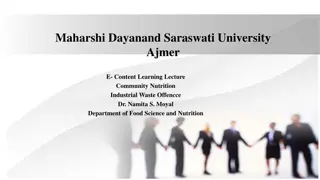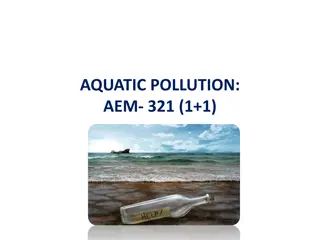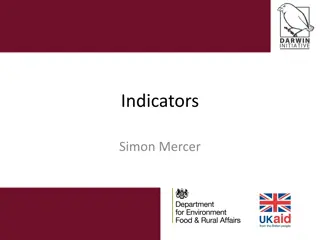Understanding Pollution: Indicators and Control Strategies
Pollution is a significant environmental issue, yet often misunderstood. This article delves into the definition of pollution, classification, and considerations for effective pollution control strategies. It discusses the UK Environmental Protection Act of 1990, pollutant properties, toxicity, and factors influencing pollution. By exploring different pollutants' characteristics and effects, we aim to enhance awareness and promote sustainable solutions for pollution prevention.
Download Presentation

Please find below an Image/Link to download the presentation.
The content on the website is provided AS IS for your information and personal use only. It may not be sold, licensed, or shared on other websites without obtaining consent from the author. Download presentation by click this link. If you encounter any issues during the download, it is possible that the publisher has removed the file from their server.
E N D
Presentation Transcript
Pollution indicators and pollution control strategies
INTRODUCTION Pollution frequently talked about of all environmental problems by the world at large and yet, in many respects, it can often remain one of the least understood. The word itself has a familiar ring to it and the concept of pollution has entered the wide consciousness as a significant part of the burgeoning greening of society in general. has become one of the most
POLLUTION The UK Environmental Protection Act (EPA) 1990, offers the following: Pollution of the contamination of the environment due to the release (into any environmental medium) from any process of substances which are capable of causing harm to man or any other living organisms supported by the environment. (EPA, Introduction) . environment means
OR the escape of any substance capable of causing harm to man or any other living organism supported by theenvironment. (EPA, Section 29, Part II) then, pollution is the introduction of substances into the environment which, by virtue of their characteristics, persistence or the quantities involved, are likely to be damaging to the health of humans, other animals otherwise compromise that environment s ability to sustain life. and plants, or
CLASSIFYING POLLUTION Classification may be made on the basis of the chemical or physical nature of the substance, its source, the environmental pathway used, the target organism affected orsimply its gross effect. Figure below shows one possible example of such a categorization system and clearly many others are possible.
The consideration of a pollutants properties is a particularly valuable examining real-life pollution effects, since such an assessment requires both the evaluation of its general properties environment. This may include factors such as: toxicity; persistence; mobility; ease of control; bioaccumulation; chemistry. approach when and the local
Toxicity Toxicity represents the potential damage to life and can be both short and long term. It is related to the concentration of pollutant and the time of exposure to it, though this relationship is not an easy one. highly toxic substances can kill in a short time, while less toxic ones require a longer period of exposure to do damage.
Persistence This is the duration of effect. Environmental persistence is a particularly important factor in pollution and is often linked to mobility and bioaccumulation. Highly toxic chemicals which are environmentally unstable and break down rapidly are less harmful than persistent substances, even though these may be less toxic.
Mobility The tendency of a pollutant to disperse or dilute is a very important factor in its overall effect, since this affects concentration. Some pollutants are not readily mobile and tend to remain in hot-spots near to their point of origin. Others spread readily and can cause widespread contamination, though often the distribution is not uniform.
Ease of control Many factors contribute to the overall ease with which any given example of pollution can be controlled, including the mobility of the pollutant, the nature, extent or duration of the pollution event and local site- specific considerations.
Bioaccumulation some pollutants, when present in very small amounts within the environment, can be taken up by living organisms and become concentrated in their tissues over time. This tendency of some chemicals to be taken up and then concentrated by living organisms is a major consideration, since even relatively low background levels of contamination may accumulate up the food chain.
Chemistry involves the break down of pollutants to form less harmful products. the breakdown products of a given pollutant can sometimes be more dangerous than the original substance. the chemistry of the pollutant itself is clearly important, other substances present and the geology of the site may also influence the outcome. Accordingly, both synergism and antagonism are possible. two or more substances occurring together produce a combined pollution outcome which is greater than simply the sum of their individual effects the combined pollution outcome is smaller than the sum of each acting alone.
THE POLLUTION ENVIRONMENT It is important to remember that pollution cannot properly be assessed without a linked examination of the environment in which it occurs. The nature of the soil or water which harbors the pollution can have a major effect on the actual expressed end-result. In the case of soil particularly, many properties may form factors in the modification of the contamination effect.
the depth of soil, its texture, type, porosity, humus content, moisture, microbial complement and biological activity can all have a bearing on the eventual pollution outcome. Hence, combination of all these factors can make accurate prediction difficult, though a consideration of system stability can often give a good indication of the most likely pollution state of a given environment.
INDICATORS In general environmental monitoring deals with two methods for the detection and quantification of the extent of pollution: 1. Physiochemical method 2. Biological method
PHYSIOCHEMICAL METHODS In the past decades, monitoring programs concentrated on the physiochemical variables. These involve the use of analytical equipment having as limitations their cost and the lack of hazard and toxicological information. This led to an increasing demand for an early-warning systems pollutants. environmental to detect the
BIOLOGICAL METHODS Bioindicators Biosensors Immunoassays
BIOINDICATORS Each organism within an ecosystem has the ability to report on the health of its environment. Bioindicators are used to : 1. detect changes in the natural environment 2. monitor for the presence of pollution and its effect on the ecosystem in which the organism lives 3. monitor the progress of environmental cleanup and test substances like drinking water for the presence of contaminants
Types of Bioindicators There are bioindicators: 1. Microbial Indicators 2. Plant Indicators 3. Animal Indicators three types of
1. MICROBIAL INDICATORS Microorganisms can be used as indicators of aquatic or terrestrial ecosystem health. Found in large quantities, microorganisms are easier to sample than other organisms. Some microorganisms will produce new proteins called stress proteins when exposed to contaminants like cadmium & benzene. These stress proteins can be used as an early warning system.
Microbial indicators can be used for testing water. EXAMPLE: Bioluminescent bacteria are being used to test water for environmental toxins. If there are toxins present in the water, the cellular metabolism of the bacteria is inhibited or disrupted. This affects either the bacteria or the amount of light emitted by the bacteria.
2. PLANT INDICATORS The presence or absence of certain plant or other vegetative life in an ecosystem can provide important clues about the health of the environment. EXAMPLE: Lichens, often found on rocks and tree trunks, are organisms consisting of both fungi & algae. They respond to environmental changes in forests, including changes in forest structures, air quality and climate. The disappearance of lichens in a forest may indicate environmental stresses such as high levels of sulphur- based pollutants & nitrogen.
3. ANIMAL INDICATORS An increase or decrease in an animal population may indicate damage to ecosystem caused by pollution. If pollution causes the depletion of important food sources, animal species dependent upon these food sources will also be reduced in number. Other indications may include the monitoring of the concentration of toxins in animal tissues or monitoring the rate at which deformities arise in animal population.
EXAMPLE:1 bioindicators. Aquatic invertebrates live in the bottom parts of waters. They are also called as benthic or benthos invertebrates and make good indicators of watershed health because they are easy to identify in a lab, have limited mobility and are integrators of environmental condition. Invertebrates can be
EXAMPLE 2:Frogs can be bioindicators of environmental quality and change. Frogs are likely to be affected by changes that occur in terrestrial & freshwater habitats and to be exposed to contaminants in air, sediment and water. Three species that can be used to examine both ecological and human health include Mourning Doves, Raccoons & fish.
BIOSENSORS Most biosensors are a combination of biological and electronic devices - often built onto a microchip. The biological component might be simply an enzyme or antibody, or even a colony of bacteria, a membrane, or an entire organism. Immobilized on a substrate, their properties change in response to some environmental effect in a way that is electronically or optically detectable. It is then possible to make quantitative measurements of pollutants with extreme precision or to very high sensitivities.
The sensors can be designed to be very selective, or sensitive to a broad range of compounds. EXAMPLE: A wide range of herbicides can be detected in river water using algal-based biosensors; the stresses inflicted on the organisms being measured as changes in the optical properties of the plant s chlorophyll.
Microbial biosensors are micro-organisms which produce a reaction upon contact with the substance to be sensed. Usually they produce light but cease to do so upon contact with substances which are toxic to them. Both naturally occurring light emitting microorganisms as well as specially developed ones are used. Positively acting bacterial constructed which start emitting light upon contact (and subsequent reaction) with a specific pollutant. In the USA such a light emitting bacterium has been approved for the detection of polyhalogenated aromatic hydrocarbons in field tests. biosensors have been
IMMUNOASSAYS Immunoassays use labeled antibodies (complex proteins produced in biological response to specific agents) and enzymes to measure pollutant levels. If a pollutant is present, the antibody attaches itself to it; the label making it detectable either through color change, fluorescence or radioactivity. Immunoassays of various types have been developed for the continuous, automated and inexpensive monitoring of pesticides such as dieldrin and parathion.
The nature of these techniques, the results of which can be as simple as a color change, make them particularly suitable for highly sensitive field testing where the time and large equipment needed for more traditional testing is impractical. Their use is however limited to pollutants which can trigger biological antibodies. If the pollutants are too reactive, they will either destroy the antibody or suppress its activity and so also the effectiveness of the test.
CLEAN TECHNOLOGY Biotechnology environmental protection has three levels of application: 1. POLLUTION CLEAN-UP 2. POLLUTION CONTROL 3. POLLUTION PROTECTION with respect to
1. POLLUTION CLEAN-UP It involves the clean-up of oil spills detoxification of contaminated soil; treatment of domestic and industrial waste-water supplies.
2. POLLUTION CONTROL It involves the recovery of heavy metals from mining water; use of enzymes chlorine in pulp manufacture. rather and than paper
3. POLLUTION PROTECTION It involves the closed cycling practice at enzyme production plants where raw materials are renewable and waste material is a biodegradable sludge which can be used as a local fertilizer.
POLLUTION CONTROL STRATEGIES Two main strategies were present earlier: 1) Dilution & Dispersal 2) Concentration & Containment
1. Dilution & Dispersal It involves the attenuation of pollutants by permitting them to become physically spread out, thereby reducing their effective point concentration. The dispersal and the consequent dilution of a given substance depends on its nature and the characteristics of the specific pathway used to achieve this. It may take place, with varying degrees of effectiveness, in air, water or soil.
AIR: Air movement gives good dispersal and dilution of gaseous emissions. WATER: There is good dispersal and dilution potential in large bodies of water or rivers, but smaller watercourses correspondingly lower capacity. SOIL: Movement through the soil represents another opportunity for the dilute and disperse approach, often with soil water playing a significant part, and typically aided by the activities of resident flora and fauna. clearly have a
2. Concentration & Containment The principle diametrically opposed to the previous approach, in that instead of relying on the pollutant becoming attenuated and spread over a wide area, it is an attempt to gather together the offending substance and prevent its escape into the surrounding environment. behind this is
AIR CONTROL TECHNOLOGY Many industrial processes cause volatile organic and inorganic odorous compounds to be emitted in large quantities. These compounds create hazards to ecosystem and to humans. The demand for odor and air pollution control systems therefore growing. Biotechnology offers one of the most economical and environmentally friendly methods for controlling odor and air pollution. 1. BIOFILTERS 2. BIOTRICKLING FILTERS 3. BIOSCRUBBERS
1. BIOFILTERS The system consists of a relatively large vessel or container, typically made of cast concrete, metal or durable plastic, which holds a filter medium of organic material such as peat, heather and bark chips. The gas to be treated is forced, or drawn, through the filter. The medium offers good water-holding capacity and soluble chemicals within the waste gas, dissolve into the film of moisture around the matrix. Bacteria, and other micro-organisms present, degrade components of the resultant solution, thereby bringing about the desired effect. The medium itself provides physical support for microbial growth, with a large surface area to volume ratio, high in internal void spaces and rich in nutrients to stimulate and sustain bacterial activity.
Biofilters need to be watered sufficiently to maintain optimum internal conditions, but water logging is to be avoided as this leads to compaction, and hence, reduced efficiency. Properly maintained, biofilters can reduce odor release by 95% or more.
2.BIOTRICKLING FILTERS Once again, an engineered vessel holds a quantity of filter medium, but in this case, it is an inert material, often cement or slag. Being highly resistant to compaction, this also provides a large number of void spaces between particles and a high surface area relative to the overall volume of the filter. The microbes form an attached growth biofilm on the surfaces of the medium. The odorous air is again forced through the filter, while water simultaneously recirculates through it, trickling down from the top, hence the name. Thus a counter-current flow is established between the rising gas and the falling water, which improves the efficiency of dissolution. The biofilm communities feed on substances in the solution passing over them, biodegrading the constituents of the smell. Process monitoring can be achieved relatively simply by directly sampling the water recirculating within the filter vessel.
3. BIOSCRUBBERS A biological treatment system and a highly efficient method of removing odor components by dissolving them. Unsurprisingly, then, it is most appropriate for hydrophilic compounds like acetone or methanol. The gas to be treated passes through a fine water spray generated as a mist or curtain within the body of the bioscrubber vessel. The contaminant is absorbed into the water, which subsequently pools to form a reservoir at the bottom. The contaminant solution is then removed to a secondary bioreactor where the actual process of biodegradation takes place. In practice, activated sludge systems are often used in this role. process control can be achieved by monitoring the water phase and adding nutrients, buffers or fresh water as appropriate.
OTHER TECHNOLOGY Absorption: Absorbing the compound in a suitable liquid; this may oxidize or neutralize it in the process. Adsorption: Activated adsorbs organic molecules; this can be tailored to give contaminant-specific optimum performance. Incineration: High temperature effective against most contaminants, but costly. Ozonation: Use of ozone to oxidize some contaminants, like hydrogen sulphide; effective but can be costly. carbon preferentially oxidation;
The main advantages of biotechnological approaches to the issue of air contamination can be summarized as: competitive capital costs; ii. low running costs; iii. low maintenance costs; iv. low noise; no carbon monoxide production; vi. avoids high temperature requirement; vii. safe processes with highly green profile; viii.robust and tolerant of fluctuation. i. v.























